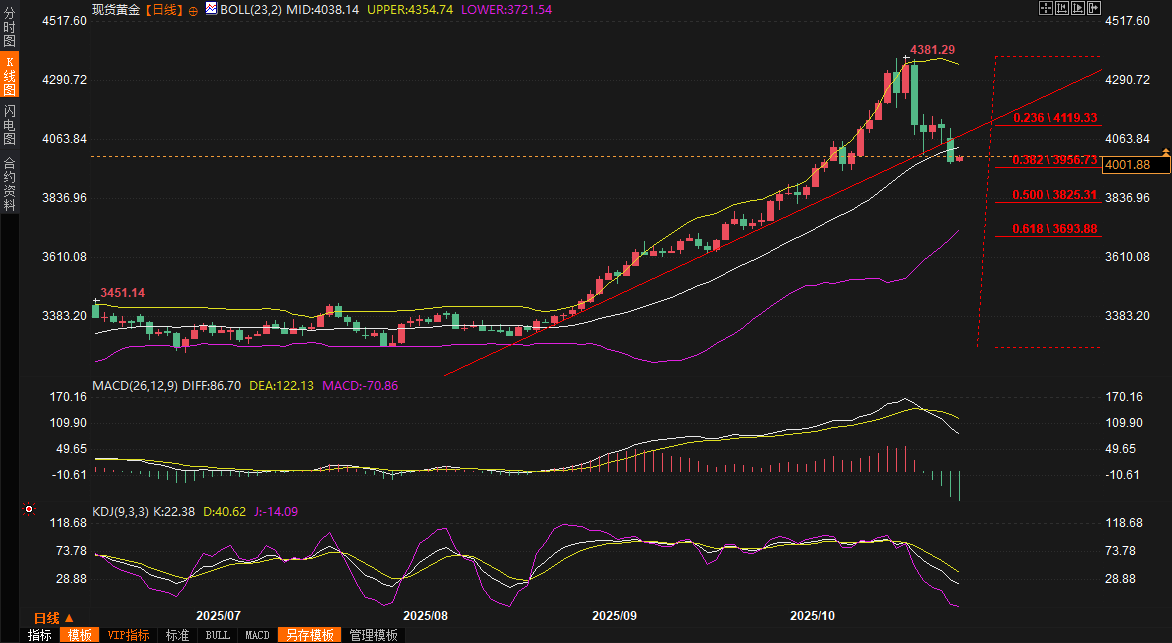Gold trading reminder: As international trade eases, gold prices once fell below the 4,000 mark. Has the wind direction changed?
2025-10-28 07:45:34

1. Why did the price of gold fall below $4,000?
US-China trade optimism dampens safe-haven demand
The decline in gold prices was primarily driven by progress in trade talks between China and the United States. Over the weekend, U.S. and Chinese negotiators reached a framework agreement during two days of talks in Malaysia, covering Chinese purchases of U.S. soybeans and the suspension of rare earth export controls. U.S. President Donald Trump and Chinese President Xi Jinping are expected to meet on Thursday to finalize the details of the agreement.
In a weekend television interview, U.S. Treasury Secretary Jeffrey Bessant clarified that both sides had reached a preliminary consensus on suspending the imposition of higher U.S. tariffs. This news significantly boosted market confidence, with major Wall Street indices hitting record closing highs for the second consecutive day. The S&P 500 index broke through 6,800 points for the first time, while the Nasdaq index rose 1.86%. Meanwhile, Wall Street's VIX index, known as the "fear index," fell to a near one-month low, reflecting fading market concerns about a trade war.
As a typical safe-haven asset, gold's price is negatively correlated with market risk appetite. David Meger, director of metals trading at High Ridge Futures, noted that "a potential US-China trade deal suggests a reduction in demand for safe-haven assets like gold."
As tensions between the world's two largest economies ease, investors are more inclined to sell gold and turn to riskier assets such as stocks and technology stocks, putting pressure on gold prices. On October 20, the price of gold soared to an all-time high of $4,381.29 per ounce, but as trade optimism grew, the price of gold fell 3.2% last week, and the decline accelerated on Monday.
Technical selling intensifies downward pressure on gold prices
In addition to fundamental factors, technical selling also played a significant role in gold's decline below $4,000. Jeffrey Christian, managing partner of CPM Group, explained that the rapid rise in gold prices from $3,800 to $4,400 in the first three weeks of October resulted in a significant accumulation of profit-taking. Amidst easing trade tensions, some investors took profits, driving the technical sell-off. This technical correction, combined with fundamental factors, further exacerbated the decline in gold prices.
II. Changes in Market Sentiment and the Macroenvironment
Expectations of a Fed rate cut dominate market focus
This week, global financial markets are focused on the Federal Reserve's interest rate decision, to be announced on Wednesday. According to the CME FedWatch tool, the market is pricing in a 98% probability of a 25 basis point rate cut. This expectation has already been fully priced in, providing limited direct support for gold prices.
However, the Fed's interest rate path and its stance on future monetary policy could still trigger market volatility. Tom di Galoma, Managing Director at Mischler Financial, noted that market uncertainty regarding the December interest rate outlook is growing, as a lack of key economic data could complicate the Fed's decision-making. For example, September's CPI data showed less-than-expected price pressure from import tariffs, which reinforced market expectations of moderating inflation but also left investors uncertain about the future path of interest rates.
Gold prices typically have an inverse correlation with real interest rates. Interest rate cuts typically reduce the opportunity cost of holding gold, thus supporting prices. However, in the current environment of rising risk appetite, even if the Federal Reserve cuts rates as planned, gold's safe-haven appeal may be offset by trade optimism. Furthermore, the Conference Board's closely watched US consumer confidence data, to be released on Tuesday, may provide further clues about the health of the US economy, thereby influencing gold prices.
The linkage effect between US Treasury yields and the US dollar trend
Dynamics in the U.S. Treasury market also provided some context for the decline in gold prices. On October 27, the 10-year U.S. Treasury yield was at 3.997%. Although the intraday change was minimal, it showed an overall slight upward trend. Jim Barnes, Head of Fixed Income at Bryn Mawr Trust, stated that hopes for a Sino-U.S. trade agreement boosted risk appetite, triggering a sell-off in U.S. Treasuries and pushing up yields. Furthermore, the results of the two-year and five-year Treasury auctions showed that investors were pushing up yields through "margin trading" before the auctions, further exacerbating volatility in the Treasury market. The two-year Treasury yield rose to 3.503%, and the five-year Treasury yield was 3.625%, both reflecting a stronger market appetite for risky assets.
Meanwhile, the US dollar index fell 0.11% to 98.84 on October 27. Marc Chandler, chief market strategist at Bannockburn Global Forex, noted that trade optimism reduced safe-haven demand for the dollar, driving its weakness. A weaker dollar typically supports gold prices, but this time, gold failed to benefit, suggesting that the decline in safe-haven demand had a more pronounced impact on gold prices.
3. Outlook for future gold price trends
Short-term pressure remains
In the short term, gold prices are likely to continue to face downward pressure. Progress in US-China trade negotiations, strong performance of global stock markets and rising US Treasury yields are all weakening gold's safe-haven appeal.
In addition, Capital Economics lowered its gold price forecast for the end of 2026, reflecting a decline in institutional optimism about long-term gold prices. If the Federal Reserve reiterates its path of gradual interest rate cuts at its meeting on Wednesday and fails to send a clear signal of ending quantitative tightening, gold prices may struggle to rebound quickly.
Long-term supporting factors remain
Despite short-term pressure on gold prices, its long-term appeal remains intact. Geopolitical risks, inflation expectations, and monetary policy uncertainty remain key factors supporting gold prices. For example, if there are setbacks in Sino-US trade negotiations, risk aversion could reignite, driving gold prices higher.
In addition, the trend of global central banks continuing to buy gold, the possibility of a long-term weakening of the US dollar and the potential rebound in inflationary pressure may all provide bottom support for gold.
Investment strategy recommendations
For investors, the current pullback in gold prices may present an opportunity to invest at a low level, but caution is advised. We recommend closely monitoring the Federal Reserve's interest rate decision and post-meeting statement, as well as the outcome of Thursday's meeting between US and Chinese leaders. If trade negotiations achieve a substantial breakthrough, gold prices could come under further pressure; conversely, if negotiations falter, safe-haven demand for gold could quickly rebound. Furthermore, tech earnings reports and consumer confidence data will provide further market guidance. Investors should consider these factors comprehensively and develop a flexible investment strategy.

(Spot gold daily chart, source: Yihuitong)
At 07:42 Beijing time, spot gold was trading at $4002.80 per ounce.
- Risk Warning and Disclaimer
- The market involves risk, and trading may not be suitable for all investors. This article is for reference only and does not constitute personal investment advice, nor does it take into account certain users’ specific investment objectives, financial situation, or other needs. Any investment decisions made based on this information are at your own risk.





















